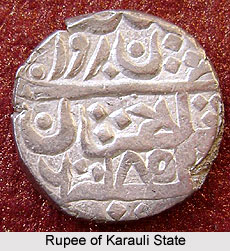 The Princely State of Karauli was one of the major states during the rule of the British Empire in India. The state was established by Raja Bijai Pal a Yaduvanshi Rajput around 995. The Karauli State was ruled by Jadon Rajputs. The region served as a fief for an extended period in the princely state of Jaipur. Later during the early 19th century, the HEIC decided to recognise Karauli state as an independent and autonomous principality. The Princely State of Karauli became a part of the Rajputana Agency in the year 1818. After the country achieved independence from the British Government of India in 1947, the princely state of Karauli was acceded to the Union of India on April 7th 1949 by the last ruler of the state, Maharaja Ganesh Pal Deo. Later the territory was merged with the Dominion of India and was incorporated as part of the Indian state of Rajasthan.
The Princely State of Karauli was one of the major states during the rule of the British Empire in India. The state was established by Raja Bijai Pal a Yaduvanshi Rajput around 995. The Karauli State was ruled by Jadon Rajputs. The region served as a fief for an extended period in the princely state of Jaipur. Later during the early 19th century, the HEIC decided to recognise Karauli state as an independent and autonomous principality. The Princely State of Karauli became a part of the Rajputana Agency in the year 1818. After the country achieved independence from the British Government of India in 1947, the princely state of Karauli was acceded to the Union of India on April 7th 1949 by the last ruler of the state, Maharaja Ganesh Pal Deo. Later the territory was merged with the Dominion of India and was incorporated as part of the Indian state of Rajasthan.
History of Princely State of Karauli
The Princely State of Karauli was situated in the region of Dhundhar, also known as Amber Kingdom or Kachwaha Kingdom or Jaipur Kingdom. This was a historical district of Rajasthan state in western India. Currently the territory includes the districts of Tonk, Sawai Madhopur, Dausa, the northern part of Karauli District and Jaipur. Mandrayal, also known as Mandrail, was the main village in the district of Karauli. In the year 1534 AD, the Raja of Amber, Puranmal, fought in the battle of Mandrail in the support of the Mughals. Later Bahadur Shah of Gujarat sieged the Chittor fort and a battle ensued with Humayun. Kachwahas became the first allies of Mughals in Rajputana. Raja Puranmal died in 1534, at the Battle of Mandrail, while providing support to Humayun and his troops to recapture the Bayana fort. Raja Bhim Singh, his younger brother, ascended to the throne of Amber, even though Puranmal had a son named Surajmal. Later Bhim Singh was succeeded by his son Raja Ratan Singh. In 1548 CE, Raja Bharmal succeeded Raja Ratan Singh.
Economy of Princely State of Karauli
The Karauli state covered a total area of 3,178 sq km and had a total population of 156,786 in the year 1901. The population of the town was 23,482. The primary agricultural produce of the region was Millets, which was the staple food of the populace. During the rule of the British, the princely state failed to witness any industrial development, although various cottage industries existed and flourished in the region such as stone-cutting, wood-turning, dyeing and weaving. Goats and rice were the main exports of the princely state of Karauli, where as cotton, salt, sugar, bullocks, buffaloes and many other items were imported.



















